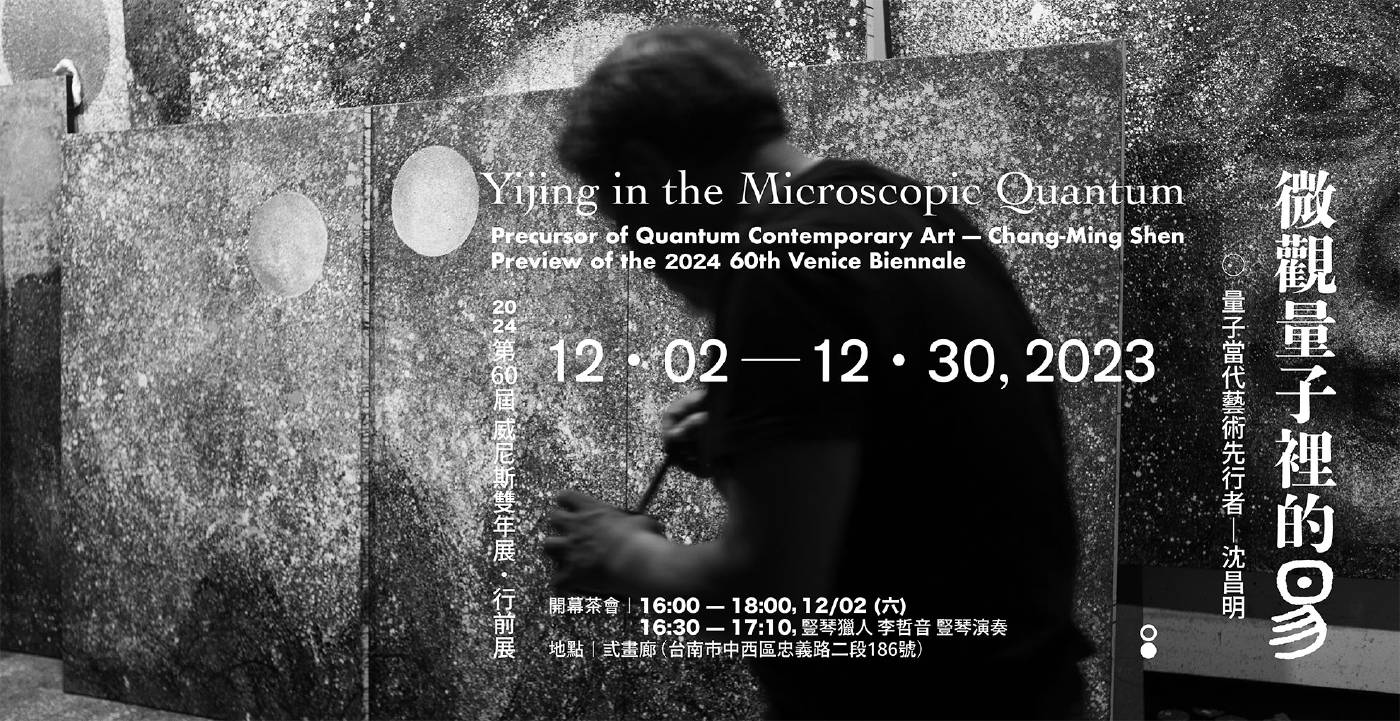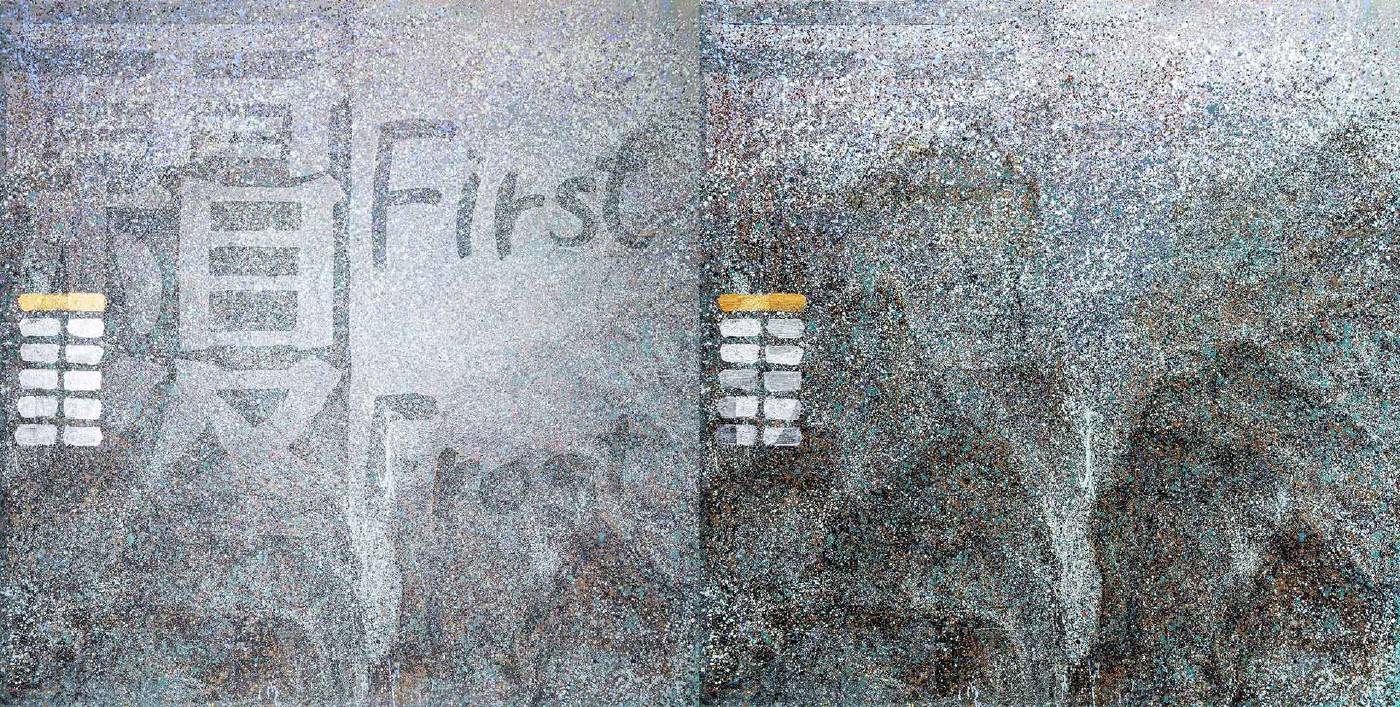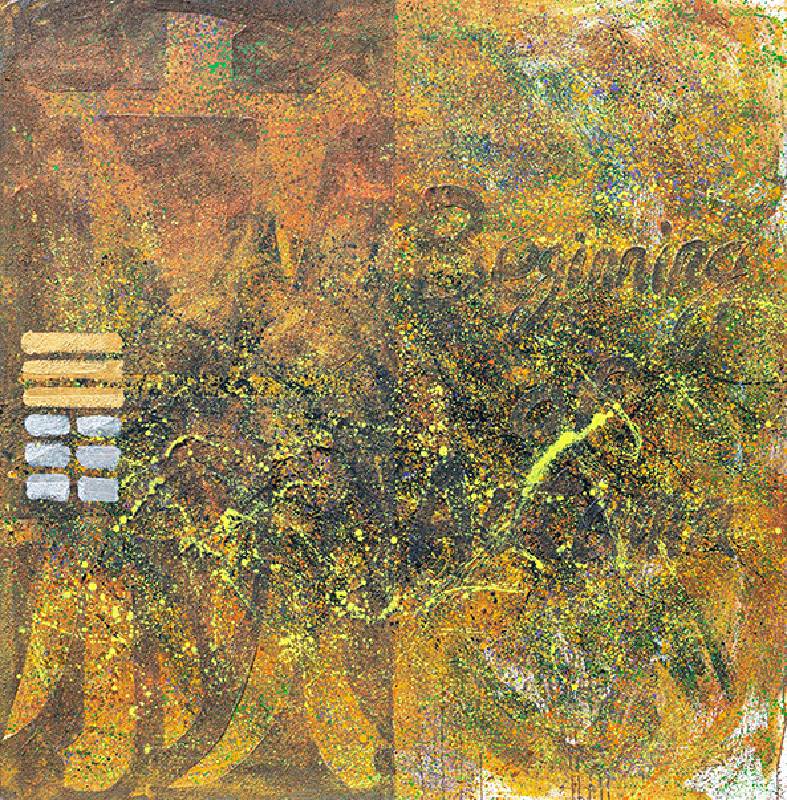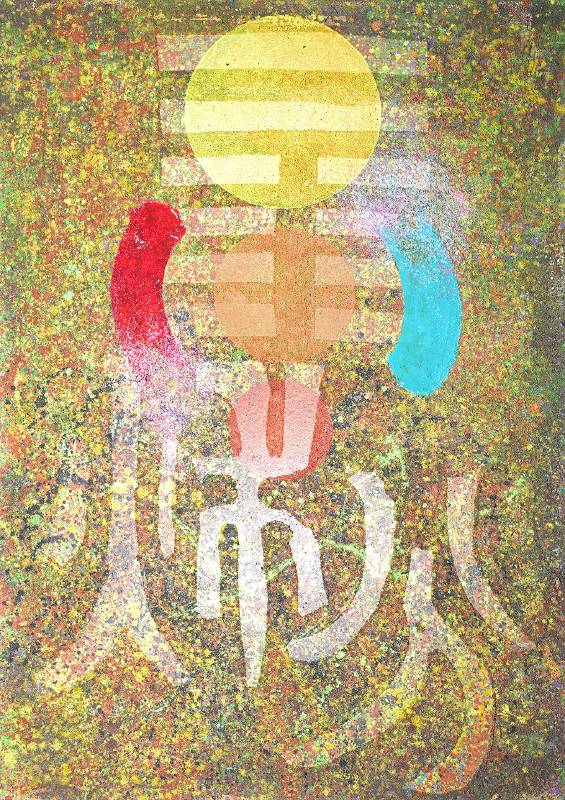弎畫廊
【微觀量子裡的易—沈昌明個展】〈2024第60屆威尼斯雙年展〉 行前展
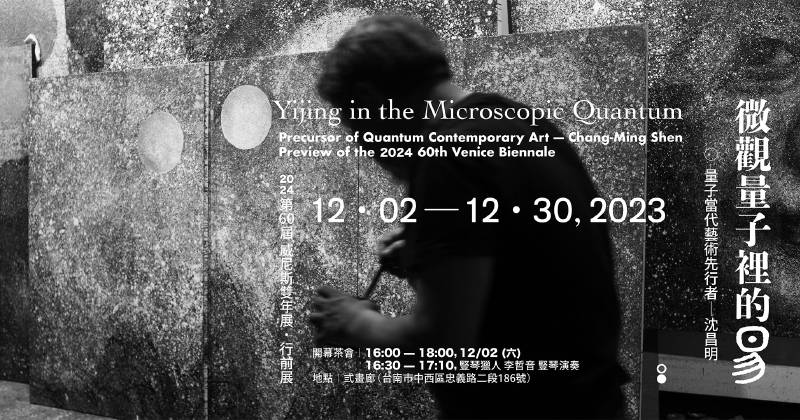
-
展期
日期:2023-12-02 ~ 2023-12-30
-
地點
弎畫廊(台南市中西區忠義路二段186號)
-
參展藝術家
沈昌明
-
沈昌明以量子力學創造的藝術視野
文/王焜生
達文西將「科學」理解為「知識」,將「藝術」理解為反映「專有技術」的方法。對於創作出一件具有不同自然元素的繪畫所投注的熱情,可能涉及整個科學研究過程。達文西所繪製的一台機器草圖或解剖圖,反映出藝術家對自然與科學的痴迷,需要有相當大的藝術天賦,方能將藝術和科學視為不可分割的組成部分。
人文與科學看似兩條不會產生交叉的平行線,100多年來隱然的在兩個領域裡產生攪動,同時提供科學家與藝術家嶄新的觀點,在理性與浪漫之間,因誤解而產生美感;因探索而發現新意。文藝復興運動確立了科學的素描造型體系,將明暗、透視、解剖等知識科學地運用到造型藝術之中;印象派則提出繪畫中色彩造型的變革,將光與色的科學觀念引入到繪畫之中,改變傳統固有色觀念,創立了以光源色和環境色為核心的現代寫生色彩學。
量子力學的提出不僅改寫了科學史與人文思潮,也對於當時的藝術家創作產生影響。俄國藝術家馬列維奇(Kazimir Malevich),認為具象的世界並不存在,唯有非具象才是唯一的存在以及世界的本質。康丁斯基的抽象繪畫仍然具有象徵主義的二元性,而蒙德里安的抽象也包含具象世界演變的根源,但絕對主義的非形象(Non-Fuguration),則反對具象世界的參考與繪畫上的任何符號。馬列維奇所創建的絕對主義
(Suprématisme)具有俄國虛無主義的傾向,深受俄國哲學思想家貝地亞夫(Nikolai Berdyaev)的影響,強調人類的自由與存在的精神意志。其思想內涵跨越艾卡特(Maître Eckart)到海德格(Martin Heidegger)的存在與現象理論,匯聚謝林(Friedrich Wilhelm Joseph von Schelling)、叔本華(Arthur Schopenhauer)和尼采(Friedrich Wilhelm Nietzsche)對物自體與表象的區分。
而在東方哲學裡,從老子的「無為自然」、莊子的「萬物齊同」,一直到淮南子的《原道訓》,不斷的闡釋「道」,覆蓋天承載地,拓展至四面八方,高到不可觸頂,深至無法測底,包裹著天地,無形中萌育萬物。所謂的「道」即是自然的精神意志。
藝術家沈昌明從一位人文主義者創作出發,經歷生命中各種的生離死別與聚散離合,體悟精神存在的絕對性,開始鑽研宇宙世界的義理。如老子「道德經」中所述:“有物混成,先天地生。寂兮寥兮,獨立不改,周行而不殆,可以為天下母。”世界萬物之生成與消失,只是意志的思考。而在科學論證的量子力學理論中,從根本上改變人類對物質結構及其相互作用的理解。
易經則是對沈昌明來說的中心經典。《易經》是中國哲學的宇宙論基礎,也是人類道德的基礎,《易經》認為陰陽運動是事物發展的基本規律。世界由陰陽兩個方面構成,兩種力量,相反相成,相互推移,不可偏廢,構成事物的本性及其運動的法則。哲學家談論的是宇宙世界的存在性,科學家則不斷探究更早的世界形成,「大爆炸」理論中,我們的宇宙不含物質,違反所有物理定律的無限細小、高溫和密集的區域。開始了一次突然和劇烈的擴張過程,使物質得以形成。艾哈邁德·法拉格·阿裡(Ahmed Farag Ali)和修恩·達斯(Sauya Das),發表文章,通過修改量子方程和軌道建設出一個新模型 。這項新假説指出宇宙是由量子流體(quantum fluid)所構成的,含有大量假想引力子(gravitons) ,由此模型推論宇宙有永久的生命,宇宙從未有開始,更不會有終結。我們對於世界的理解從原先的本體論(ontology)變成了認識論(epistemic)。斯賓諾莎在《倫理學》中對神的看法是,他認為神是決定論宇宙的一環,沒有任何事情是偶然發生的。愛因斯坦從斯賓諾莎思想的精神中發展出一套決定性本質的概念,認為萬物規律受到嚴格的法則所規範。
從東西方哲學、人文與科學的宇宙生成及現象,沈昌明自創出一套從生命體悟到藝術創作的量子力學藝術論與信念,「為了紀念去世的兒子,在畫布上一遍一遍的抄寫心經,多次以後形成特殊的肌理,讓我體悟到一種陰陽和虛實的概念以及開啟了我新的創作方式。而創作的過程也是一種自我觀照,同時慢慢體悟到人生很多事不用太過執著,每個人都是來自共同的磁場、場域的一個能量,脫離這一世肉身之後會回歸本源!」
一件畫布即是一個生成的宇宙,在藝術家未加入自己的意志之前,這個畫布的世界已經存在,而透過時間與空間在畫布上的累加,藝術家的信念與意志疊加於畫布之上,循序產生了另一個現象的世界。但是原來的世界還是存在著,只是表現的形式有了差異,在我們眼中所見有了不同,然而本質卻一直都存在著初始。沈昌明在畫布裡將自己所感知的宇宙以油彩潑灑於畫布上,如同每個最基本的量子元素,形成世界的樣貌。而這個世界是屬於藝術家所感知、所創造的。
《易經》始於乾坤二卦,乾卦由六陽爻而坤卦由六陰爻構成,因此乾為純陽而坤為純陰。既然實際存有物都必須有陰也有陽,乾坤所代表必然是抽象的原則。從日月轉換、四季遞迭、到一沙一葉的見微知著。沈昌明透過量子力學理論,將屬於過度浪漫情緒的部份導向理性的中和,以科學探究的精神來閱讀易經及日常所想。在他的繪畫中,常有超脫意識之外的直覺,但又隨時將觀者拉回現實的理性。
將繪畫當作是科學的研究,把量子元素以實驗的精神置入繪畫裡,透過顏料與細沙的攪拌,製造出色彩既匯聚又獨立的效果,在視覺上呈現的繽紛豐富,超越印象派處理光影的科學理論。而在東方思想裡,一沙即是一個世界,每個世界都包含著萬千的質素,每個世界又再結合成另一個更大的宇宙。沙呈現肉眼能看見的最小微粒,來比擬量子,以量子組構世界萬象,他以沙浮雕加以隸篆心經的書寫,在畫面上作出具兩個層次的空間,畫中的每一筆觸都透露著形而上及「道」的哲理。
在技法上,以潑灑強化了視覺的豐富性,以雕刻的陰陽技法,將立體雕塑在平面繪畫上呈現三度空間的視覺效果,類似篆刻的繪畫方法,將畫面的空間感建構出得以負載更多留白的效果,在虛與實之間既抽象有具體;以視覺錯位,在不同角度觀賞時,出現文字與圖像的交錯,成為閱讀與觀賞的兩種體驗,而每個文字本身所蘊義的則又是獨特的完整世界。在一個畫面上所創造出來的多樣變化也是沈昌明多年來深入研究所創造出來的個人藝術成就。
先行者或許孤獨,但不會寂寞。孤獨是沉潛的必要,在晨昏定省間照見內心也對世界的理解更加清明。透過沈昌明所創造的量子力學繪畫裡,我們也發現了新的世界,不只在雙眼所見,更在心靈所感。
Artistic energy created with quantum mechanics by Sheng Chang-Ming
Emerson Wang
Leonardo da Vinci understood "science" as "knowledge" and "art" as a method of reflecting "specialized techniques." The passion invested in creating a painting with various natural elements may involve the entire scientific research process. Leonardo's sketches of machines or anatomical drawings, reflecting the artist's fascination with both nature and science, require significant artistic talent to view art and science as inseparable components.
Humanities and science, seemingly two parallel lines that do not intersect, have quietly stirred within both fields for over a century, providing scientists and artists with fresh perspectives. They exist in the space between reason and romance, generating aesthetics through misunderstandings and discovering novelty through exploration. The Renaissance movement established a scientific approach to artistic representation, incorporating knowledge of light and shadow, perspective, anatomy, and more into the realm of visual art. The Impressionist movement, on the other hand, proposed a transformation in the use of color and form in painting, introducing scientific concepts of light and color into the art, challenging traditional notions of color, and establishing a modern study of color theory centered around primary and ambient colors.
The emergence of quantum mechanics not only reshaped the history of science and intellectual trends but also had an impact on the work of artists of that era. Russian artist Kazimir Malevich, for instance, believed that the tangible world did not truly exist, and only non-objectivity represented the sole existence and essence of the world. While Kandinsky's abstract paintings still retained a symbolism with a duality of representation, and Mondrian's abstract work contained the origins of the tangible world's evolution, absolute non-figuration, as advocated by Malevich, rejected any reference to the tangible world or symbols in painting. Malevich's creation of Suprematism had a tendency toward Russian nihilism, deeply influenced by Russian philosopher Nikolai Berdyaev, emphasizing human freedom and the spiritual will of existence. His philosophical content traversed theories of existence and phenomenology from figures like Eckhart to Heidegger, drawing on the distinction between substance and appearance as presented by Schelling, Schopenhauer, and Nietzsche.
In Eastern philosophy, from Laozi's "Wei Wu Wei" (actionless action) to Zhuangzi's "All things are the same," and even in Huainanzi's "Original Way," the concept of "Dao" has been continuously expounded upon. It extends from the heavens to encompass the earth, expands in all directions, reaching incomprehensible heights and depths, enveloping the universe, and in its invisibility, nurtures all things. This "Dao" is, in essence, the spiritual will of nature.
Artist Shen Changming, starting from a humanistic perspective, has experienced the various comings and goings, life and death, and reunions and separations in his life. Through these experiences, he has come to understand the absolute nature of spiritual existence and embarked on a journey to explore the principles of the cosmic world. As described in the Tao Te Ching by Laozi: "Something mysteriously formed, born before heaven and earth. In the silence and the void, standing alone and unchanging, ever-circulating without end, able to be the mother of the world." The creation and dissolution of all things in the world are merely reflections of the will. In the scientific realm, the theory of quantum mechanics fundamentally alters humanity's understanding of material structures and their interactions.
The "Yijing" holds a central place in Shen Changming's perspective. The "Yijing" serves as the cosmological foundation of Chinese philosophy and the bedrock of human ethics. It posits that the interplay of yin and yang is the fundamental law governing the development of all things. The world is composed of these two aspects, two forces, which are complementary, mutually transformative, and must not be neglected. They constitute the essence of things and the laws governing their movements. Philosophers discuss the existence of the cosmic world, while scientists continually probe the origins of the universe.
In the "Big Bang" theory, our universe originated from a region of infinite smallness, high temperature, and density devoid of matter, violating all known physical laws. It initiated a sudden and dramatic expansion process, allowing matter to form. Ahmed Farag Ali and Saurya Das published a paper proposing a new model by modifying quantum equations and constructing orbits. This novel hypothesis posits that the universe is composed of a quantum fluid containing numerous hypothetical gravitons. According to this model, the universe has eternal life, never had a beginning, and will never have an end. Our understanding of the world has shifted from ontology to epistemology.
Spinoza's view of God in "Ethics" is that God is an integral part of a deterministic universe where nothing happens by chance. Einstein developed a concept of deterministic nature inspired by Spinoza's philosophy, believing that all things are governed by strict laws.
Drawing from both Eastern and Western philosophy, the humanities, and the science of cosmogenesis and phenomena, Shen Changming has developed a unique quantum art theory and belief system that spans from life's insights to artistic creation. "In memory of my departed son, I repeatedly transcribed the Heart Sutra onto the canvas, creating a distinctive texture after numerous repetitions. This process led me to grasp the concept of yin and yang, as well as the interplay of the virtual and the real, opening up a new creative path for me. The act of creation is also a form of self-reflection, and I gradually came to realize that many things in life need not be overly attached to. Each person is an energy emanating from a shared magnetic field and domain. After departing this physical existence, we return to our source."
A canvas is, in essence, a generated universe. Before an artist imparts their will onto it, the world of this canvas already exists. Through the accumulation of time and space on the canvas, the artist's beliefs and intentions overlay upon it, sequentially creating another world of phenomena. However, the original world still exists; it's just taken on a different form, seen differently through our eyes. Yet, its essence has always remained unchanged. Within the canvas, Shen Changming splatters oil paint, representing the universe as he perceives it, akin to the most fundamental quantum elements, shaping the appearance of a world. And this world belongs to the artist's perception and creation.
The "Yijing" begins with the two hexagrams of Qian and Kun, with Qian composed of six yang lines and Kun composed of six yin lines. Therefore, Qian represents pure yang, while Kun represents pure yin. Since everything in actual existence must have both yin and yang aspects, what Qian and Kun represent is undoubtedly an abstract principle. This principle can be observed in the transitions of day and night, the changing seasons, and even in the smallest details like grains of sand and individual leaves. Shen Changming, drawing from quantum mechanics theory, channels the overly romantic aspects towards a rational balance, approaching the "Yijing" and everyday thoughts with a scientific spirit. In his paintings, there is often an intuitive element beyond consciousness, but he always brings the viewer back to reality with rationality.
Approaching painting as a scientific study, Shen Changming infuses the spirit of experimentation into his artwork. He introduces quantum elements into his paintings by mixing pigments with fine sand, creating an effect where colors both converge and stand independently, resulting in a visually vibrant and rich composition that transcends the scientific theories of light and shadow found in Impressionism. In Eastern thought, every grain of sand represents a world, each world containing myriad qualities, and these worlds combine to form a larger universe. Sand symbolizes the smallest visible particles, analogous to the quantum realm, where quantum elements construct the diversity of the world. Shen utilizes sand relief carving alongside the transcription of Heart Sutra in seal script, creating a dual-layered spatial dimension within the artwork. Each stroke in the painting exudes metaphysical and philosophical concepts of "Dao."
In terms of technique, he enhances visual richness through splattering, and he employs a yin-yang carving technique to bring three-dimensional sculptural effects to two-dimensional paintings. Similar to the method used in seal engraving, he constructs spatial depth in the artwork, allowing for more whitespace, blurring the line between abstraction and concreteness. By employing visual misalignment, when viewed from different angles, the artwork presents an interplay between text and image, offering two distinct experiences for reading and viewing. Moreover, each individual character carries its unique and complete world within it. The diverse variations created within a single composition are a testament to Shen Changming's artistic achievements developed through years of in-depth exploration.
Pioneers may be solitary, but they are never lonely. Solitude is a necessary immersion, revealing the depths of one's being and providing a clearer understanding of the world during moments of introspection between day and night. Through Shen Changming's creation of quantum art, we also discover a new world, not only visible to the eyes but also felt within the soul.
✦ 展名 |微觀量子裡的易
量子當代藝術先行者—沈昌明
〈2024第60屆威尼斯雙年展〉 行前展
✦ 地點 |弎畫廊(台南市中西區忠義路二段186號)
✦ 參展藝術家 |沈昌明 Chang-Ming Shen
✦ 展期 | 2023/12/2(六)-2023/12/30(六)
✦ 開幕茶會暨藝術家導覽 | 12/2(六) 下午4:30-6:00
